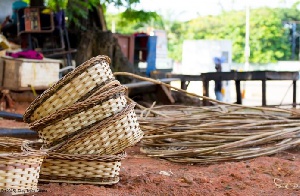He starts by peeling the bark off the rattan, which we know as cane, and then cuts them into pieces that can be used for weaving furniture, baskets, wardrobes, and lamp-shades among others. This is no small task as it can take as long as five days to complete a set of furniture, for example.
Yet Kweku Mante, someone who has been in the business of cane-weaving since his early teens, says business is slow. Patronage has dropped sharply as buyers have developed a taste for the same products imported from China.
The Chinese replicas, he told the B&FT, have taken over the local market due to their nicer-looking finishing and relative affordability.
For example, a set of furniture that Kweku sells for GH¢2,500, owing to his higher production cost, is sold at GH¢1,800 by the Chinese who enjoy cheaper costs of production.
Again, since the Chinese produce with modern and sophisticated machines, their products come out with a finer finish than the local ones produced manually.
The situation, Mr. Mante said, has made the weaving industry unattractive to potential entrants as existing ones want out. This is in spite of the abundance of rattan and bamboo in the country, which guarantees the industry a ready source of raw materials.
According to Mr. Mante, the Western Region – where most weavers purchase their raw materials from – is flooded with a lot of rattan.
With the country’s unemployment rate rising day by day, estimated at about 12 percent, representing 1.2 million of the population from persons aged 15-years and above, this industry is one of many waiting to receive the attention needed to help reduce youth unemployment.
See Also: BoG begs time for lending rate to fall...as it reduces policy rate to 20 percent
In India, the rattan industry employs more than 2 million people directly and 5 million part-time. It is estimated to generate more than US$1.4billion of that country’s GDP annually.
In Peru, it employs more than 200,000 people directly, and 1.6 million people part-time; and generates an estimated US$13million to its economy annually.
The total value of China’s bamboo industry in 2015 was US$30billion. By 2012, the number of people directly employed in bamboo activities in China was close to 8 million.
According to Statista. Com, the value of the bamboo and rattan products industry in the UK is estimated at £3.4billion, whereas the US has raked in revenue of more than US$280-million since the beginning of 2018.
Iran and the Philippines also gain an estimated annual revenue of US$200million and US$590million respectively from this industry.
While there is hardly any data to gauge its value in Ghana, the industry employs quite a number of people – most of whom pitch makeshift camps along some streets in Accra and elsewhere to exhibit their weaving talents.
Most of these artisans operate on a very small scale, using old methods of production – which renders their final products clumsy and not very attractive to consumers.
Industry players say support from government has been non-existent for many years – except for this year when the Member of Parliament for La Dadekotopon Constituency, Vincent Sowah Odotei, facilitated a training programme for the local players, with Chinese experts as trainers, no effort has been made by government to help the industry.
Mr. Mante called on government to extend more support to the industry, especially financial aid that will help them buy modern equipment to produce and rival Chinese products.
See Also: HFC Bank signs MoU with University of Ghana
He argues that if government does this, more youth will find the industry attractive and lucrative; thereby, plying their trade in the sector.
The global trade statistics on the bamboo and rattan industry
According to research by the International Trade of Bamboo and Rattan (INBAR), bamboo and rattan are mostly traded within and between Asia and Europe. Asia is the main source of bamboo and rattan products, while Europe, Asia and North America are the major importing markets.
In 2014, the export value of bamboo and rattan products from Asia reached US$1.5 billion; meaning the continent accounted for 85 percent of world exports. China is the largest producer and exporter of bamboo and rattan products in the world. It accounted for 65 percent of the world exports of bamboo and rattan products in 2014, with a value of US$1.9billion.
Europe is the second-largest exporter with US$197 million, equivalent to 11 percent of the world total. In addition, with a value of US$635 million, Europe accounted for 39 percent of world imports of bamboo and rattan – making it the world’s largest import market.
Imports from Asia and North America contributed 33 percent and 19 percent to the world imports. Europe, Asia, and North America collectively account for 92 percent of the world imports by value.
The USA imported US$276million of bamboo and rattan products from the world in 2014, 17 percent of world imports.
Japan is the third-largest importer of bamboo and rattan products, with a market share of 14 percent.
Business News of Thursday, 25 October 2018
Source: thebftonline.com

















